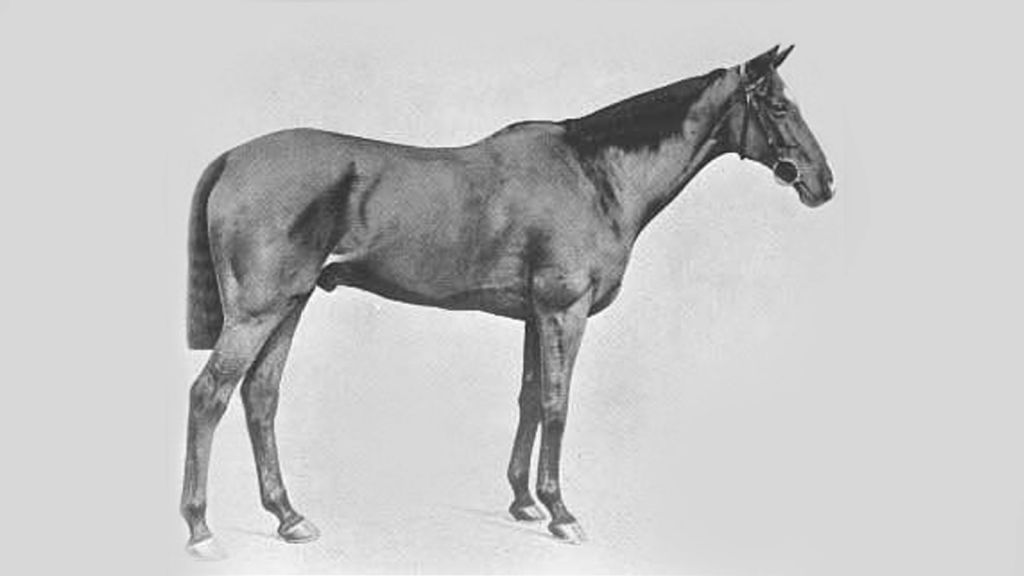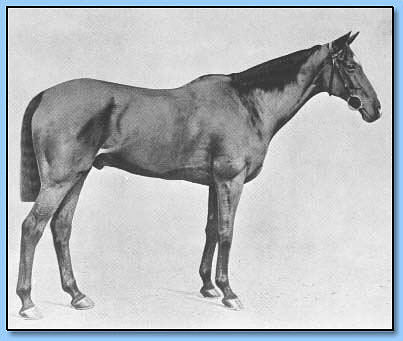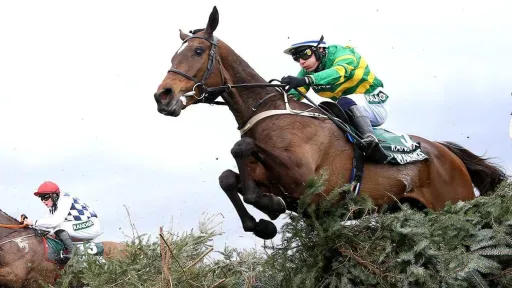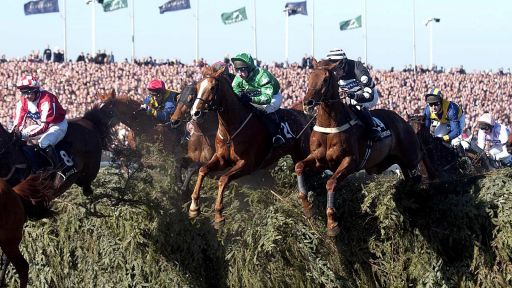Manifesto

Who is the Greatest Grand National Horse of all time?
The bay with a white star on his forehead by Man of War (by Ben Battle by Rataplan) out of Vae Victus by King Victory , was a tough well proportioned and powerful horse which was just as well as he Jointly holds the record for the highest weight carried by a wining horse that of 12st 7 lbs. He also holds the record weight for a placed horse of 12st 13 lbs.

Manifesto was bred in Ireland by solicitor and farmer Mr Harry Dyas. Many horses were run extensively in their early years but Mr. Dyas saw the potential in this unfurnished young horse and it was to his credit that he had enough foresight to be patient with the horse in his early years, this was to pay off in the long run as the horse ran well at a much older age than most racehorses. Manifesto's first run in 1892, was a short while after he had turned four. It was definitely not an omen for what was to come. The race was a steeplechase in Manchester and unfortunately he fell. His next race was a month later and was also at Manchester and this time he was entered in a hurdle race. There was a much better result that day as he won the race. The prize money was the princely sum of 39 pounds. He ran twice more before being entered in the Irish Champion Steeplechase in Leopardstown where he went on to win the race. The following year 1893 he ran only twice winning one race at Derby, and running at Gatwick (where the National was later to be run during the war years).
In 1894 he ran two races one of them was when he won The Lancashire.
1895
In 1895 he again raced in two races one was a National Hunt flat race and the other was the 1885 Grand National where he was asked to carry 11st2lbs. The weather for the 1985 Grand National was very foggy and you could not see much of the race from the stands. Manifesto ran very well and took to the fences really well. There were some fine horses running that day with Aesop who was second behind Cloister two years earlier, and two previous winners Father o'Flynn and Why Not. Manifesto was ridden up with the pace and was going well and only got tired in the closing stages and finished a creditable fourth behind the winner Wild Man From Borneo, Cathal in second and Van Der Berg in third place. Manifesto had to give all these horses weight in heavy ground.
1896
In 1896 he ran three times, He was unplaced in The Midland Chase at Nottingham and won a walkover for 98 pounds in Manchester, but we need to tell the story of his National run. This was not a good year for him as he fell at the first fence. The records show that there was some collision between him and another of the runners called Red Hill, It is not clear who brought down who, however it still remains a fact that he fell that year. Incidentally many successful horses and jockeys seem to fall at the first, after winning, or then go on to win the race, so don't rule out your fancy forever if he/she falls at the first.
1897
1897 was the first of the real glory days for the horse. When the declarations were announced for the race Mr Dyas had two entries Manifesto who on this occasion was given a more realistic weight of 11st 3lbs and also a mare called Gentle Ida who Mr. Dyas was said to have thought the world of. So it was strange that a month before the race Mr. Dyas was prepared to sell either of these horses or both of them for the sum of 5000 pounds. He engaged the services of Mr Tom Vigors who was a well-known seller of horses from Irish stables to English owners. Mr. Dyas was straight with the sale and told Mr. Vigors that he thought one of this pair of horses would win The Grand National. Luckily Mr Vigors could not find buyers so both were set to run in the Dyas Colours.
On the run up to the race it was well known that although Manifesto was being hailed more and more by the general public, Mr Dyas thought that the mare had the better chance. So it was perhaps with some relief to the betting public that Gentle Ida was withdrawn and Manifesto became the race favorite.
The weather on the day of the race was overcast and there was a strong, large field of 28 runners, the going on the day was good and there were two previous winners in the field, Wild Man from Borneo and The Soarer. The first start was a false start but the runners got away the second time. Manifesto stayed at the front of the pack lying in second place for most of the race. In the race nothing fell until the Canal turn, which is late even now for the first casualties. Wild Man from Borneo was cannoned into and was soon pulled up. On the second circuit when they got to Bechers brook Timon and Manifesto were together closely followed by Nelly Grey, Cathal and Ford of Fyne with Fairy Queen, Filbert and The Soarer up with the pack. At Valentines The Soarer fell and his jockey not only had to suffer the indignation of the fall but also had to nurse a broken collarbone. Two from home there were two horses battling it out Manifesto who jumped superbly and Timon who blundered and unseated his rider.
Manifesto was now left a long way in front and only one horse had a chance to catch him, Cathal who was second in 1895 and 8th in 1896 was giving chase when he fell at the last. He was thought to have been killed in his fall as he lay motionless for a long time, when the vet got to him, He could see that the horse had swallowed his tongue. The brave vet pulled it back into position and the horse duly got up and in gratitude severely bit the vet. Manifesto was now left way out in front. What a magnificent sight this must have been the great horse striding to the winning line twenty lengths in front of his nearest rivals, given a favorites cheer by the large crowd, a roar as he crossed the line and the subsequent applause back to the winners enclosure. The elated jockey Terry Kavanagh had been trying to win The National for ten years said after the race " If I had liked I could have gone to the front at any time in the course of the race, and could have made all the running if necessary".
Manifesto ran twice more in this season, the first was a run in the Lancashire again, but he seemed to lose his concentration at what must have seemed liked much smaller fences and fell. He then ran in the race that was to become the Whitbread, "The Grand International" at Sandown and duly won this race carrying a massive weight of 12st 10lbs giving 32lbs to the runner up.
1898
1898 was the year that Manifesto was to be sold, after winning a race at Gatwick in February he was sold to Mr Bulteel for the then massive sum of 4000 pounds. His first race for the new owner was a flat race at Kempton. He was entered in the Grand National but a week before the race his stable was left unlatched and the horse got free, he galloped across country tried to jump a 5ft gate misjudged it and damaged his fetlock, the injury was to keep him out for some months and he was scratched from the race. The stable lad did a runner and it was said that he went to work for another stable under an assumed name. Mr Dyas also sold Gentle Ida that year.
The 1898 Grand National was run in a snowstorm and was won by Drogheda.
1899
Although Mr Dyas had sold Gentle Ida he still had her in his stable and thought very highly of her, Two years previously he was said to have told that he thought she was better than Manifesto at level weights and was very bullish about her chances when she was entered for the National, as she was to be receiving a stone from Manifesto, so high was his opinion of her that he could see no horse beating her giving her that much weight. His enthusiasm was very contagious especially with her new owner Mr Bottomley, and the public soon caught on to this good thing and Gentle Ida was favourite for the race with Manifesto second favourite at 4/1 and 5/1 respectively. The weather for the race was a fine and sunny day, but Manifesto had to carry an enormous weight on the day of 12st 7lbs.
There were other good horses in the race of course and one of the best was Ambush II who was to win the race the following year.
Once the race was underway the smart Corner took up the running, despite the good weather on the day there were some soft patches on the course and hay had been placed around the take off and landing positions on the canal turn fence. It had been forgotten about and at the start of the race it had not been removed. Manifesto lying in mid-field jumped the fence with his usual flamboyance only to land on the hay and slip, the horse crumpled on landing and went down on his shoulder. Amazingly the horse found a leg and the jockey just sitting still felt the great horse rise from almost certain disaster to run on. The Jockey was later to comment "I saw one of his legs sticking straight up over my head in the air, The toe of my boot was on the ground, and both my irons were gone, But I left everything to Manifesto, and when he recovered I just picked up the reins and went on".
After this nothing was going to stop him. At the next fence his old stalemate made a mistake and fell, Gentle Ida the favourite was out of the race.
At the end of the first circuit Mum was the leader and Manifesto was some way down the field with a good number of horses still continuing.
On the second circuit Manifesto made up relentless ground as did Ambush II and at Becher's for the second time they were together and just behind the leaders, Manifesto strode on and soon was in front and stamping his authority on 'his race', at the second last the cheers of the crowd were deafening and the great 11 year old was striding out and getting further away from his pursuers.
At the last he was superb and the result was now not in doubt the cheers came to a crescendo as the great horse once again crossed the line despite the weight and despite the near fall and came home safe and sound five lengths ahead of his nearest rival.
His then owner was said to have taken many thousands of pounds in betting winnings from the ring, and knowing what part the jockey had played in the victory by 'just sitting still and not panicking' gave him a present of 2,800 pounds.
1900
Because of his reputation the handicapper gave Manifesto 12st.13lbs to carry in the 1900 Grand National. Not only was he to carry this weight but he was also to give every one of his challengers in the race at least 48 lbs. (The great Arkle was once asked to give 49 lbs but that was not in a National). I know this is supposed to be a handicap race but to give ANY horse this weight to carry would be just giving the horse no chance especially in this gruelling race and at a grand age of 12 years old. Surely no horse could even finish the race in a reasonable time with this much weight? Well not quite you see this horse just had so much heart he would simply not be stopped and gave one of the most brilliant performances ever seen.
In the race Covert Hack was one of the fancied runners but he came to grief at the first fence, and as Barsac took up the lead he was still challenging for the lead with the race favourite Hidden Mystery, but the loose rider-less horse Covert Hack was running eccentrically and when they completed the first circuit and got to the fence that he had fallen at the first time he interfered with the favourite and caused him to fall. George Williamson, Manifesto's Jockey was again giving the horse a good steady ride and when the leaders were coming to the final straight there were two horses in the race with a chance of winning, Manifesto and The Prince of Wales' horse Ambush II, as they cleared the last and started the run in it began to become clear that the burden of the welter weight was beginning to tell and Ambush II went clear of Manifesto. Seeing that Manifesto could not possibly win the jockey eased him and rightly so. There is no point in giving a horse that had given his all, a hard time. Manifesto was eventually beaten a short head for third by Barsac.
I am going to conclude this chapter with and extract of a piece written of this great race:- It is impossible to describe this tremendous race. No one will ever describe it adequately. Men who saw it know in their own minds what it was, and what their own feelings were when the grand old Manifesto made his supreme effort under 12st 13lbs and up to a hundred years from the finish looked like getting there. The scene of Persimmon's Derby (The Prince of Wales horse who won) was nothing to that of today, and yet there were actually tears in men's eyes at the thought of Manifesto's defeat, I can write no more about it. There are some things about which it appears almost sacrilege to write in commonplace black and white"
1901
Manifesto did not run in the race due to a training problem as he was 13 years old and the public must have thought they had seen the last of this old horse.
1902
At 14 years old Manifesto was again entered to run in the National. He was not very well fancied on the day and one of the reasons would have been that he was allocated top weight again. He was to carry 12st 8lbs. We must put this into context, No 14 year old horse had ever made the frame up to then, or has done so since (with one exception and we will get to that later) and no horse since this year has made the frame with 12st 8lbs or higher.
The favourite for the race was Drumcree and as they set off the favourite was out in front. Manifesto had a new jockey this year as his regular pilot was not available, it was Ernie Piggott. Ernie laid Manifesto out at the back early on and took some criticism for his riding tactics but on an ageing horse with such a big weight his tactics proved to be sound.
By the time they had reached the Canal Turn on the second circuit Manifesto was well behind and had to come under pressure, He responded like the good horse he was and started to give his jockey more. He made up ground relentlessly. As the leaders jumped the last it was plain that Manifesto was not going to win. As the two in front of him jostled for position the cheers from the crowd were deafening but they were not for the Winner Shannon Lass or the second Matthew but for the gallant Aintree hero who once again was giving his all for his connections and supporters. This was another year where the winner had to share the accolades with Aintree's finest.
1903
Manifesto now 15 years old was declared again for this historic race where another first in the history of the race was to take place as the first horse to represent a reining monarch was to run, Ambush II .
This year Manifesto was not to be top weight, that was to go to The Kings Horse at 12st 7lbs but Manifesto was not to be given a racing weight as he still had to carry 12st 3lbs.
In the race there were a lot of early fallers and only 12 runners were left on the second circuit.
At the second last there were five horses left with a chance Ambush II fell at the last and soon after the last Drumcree was 'seized with a fit of the staggers', and fell on the flat, that left Drumcree (9 years old 11st3lbs), Detail (7 years old 9st 13lbs), Kirkland(7 years old 10st 8lbs) and Manifesto (15 years old 12st3lbs) in the running.
Drumcree soon went clear and was chased to the line by Detail, The race was still on for third place however, and the Mighty Manifesto again pulled out more to beat Kirkland to third place. Once again Manifesto received the biggest cheer of the day.
1904
Manifesto was now 16 years old and surly would be given a lightweight? Well that was not to be and he was set to carry 12st 1lb in the race. Manifesto gave another great performance but the toll of the years were to catch him up this time. I have seen other horses give up with lighter weights than this and at a much earlier time in their career but not Manifesto. He was called on to give one final effort and so he did and finished the race last of the six to finish and who would say this was not another monumental run from this horse.
So this was the horses record in the race 4th, fell, 1st, 1st, 3rd, 3rd, 3rd and unplaced I can see no argument against the question I set at the top of this page.
Manifesto surly was the greatest Grand National horse of all time.
The story however does not end here.
The horse was such a magnificent specimen, that after his death his skeleton was donated to a veterinary college in Liverpool and is still there to this day.
Recently the cup and colours that the Dyas family have had in their keeping were loaned to The Grand National museum in Liverpool. This was done at a visit to the Nigel Twiston Davies yard, where the trophy was presented to the museum by Mr Kim Dyas.
The twice Grand National winning jockey Carl Llewellyn received the cup on behalf of the Grand National Museum wearing the original silks in the Dyas colours worn by Terry Kavanagh on 26th March 1897 when Manifesto won The Grand National
Thanks
I must give my most sincere and heartfelt thanks to Laura Dyas. Laura is the only child of Harry Dyas and without her input, not only would we not have had these great photographs of these magnificent days, but these original Dyas Grand National winning silks and the 1897 winning cup would probably have never been seen again. It is through Laura's kindness that the public can again see these items in all their glory. So thank you Laura for bringing these items to the public again and a personal thank you from me, for allowing me to show these photographs on my tribute to Manifesto The Greatest Grand National horse ever.


